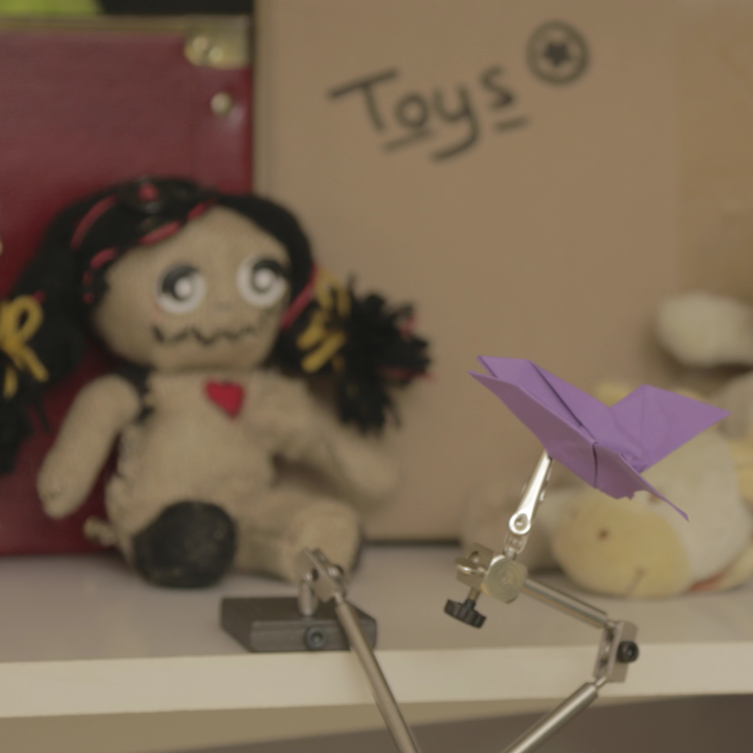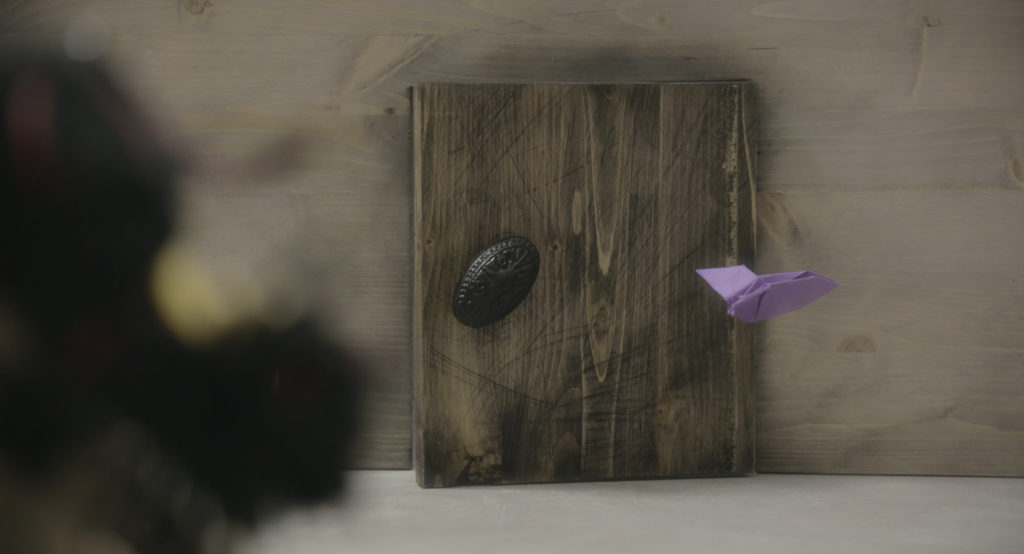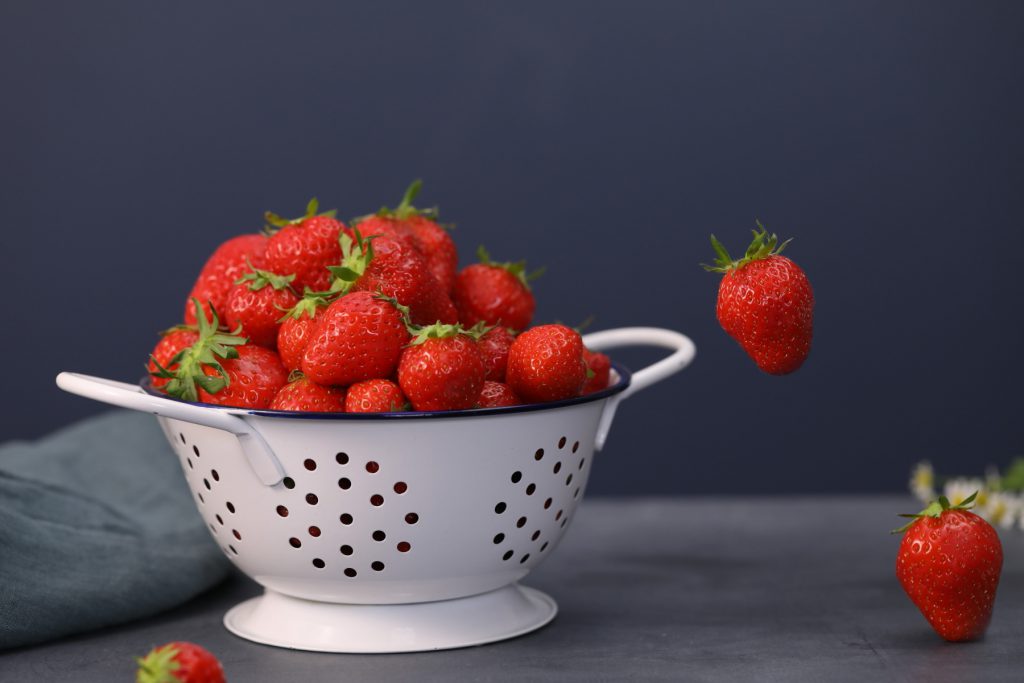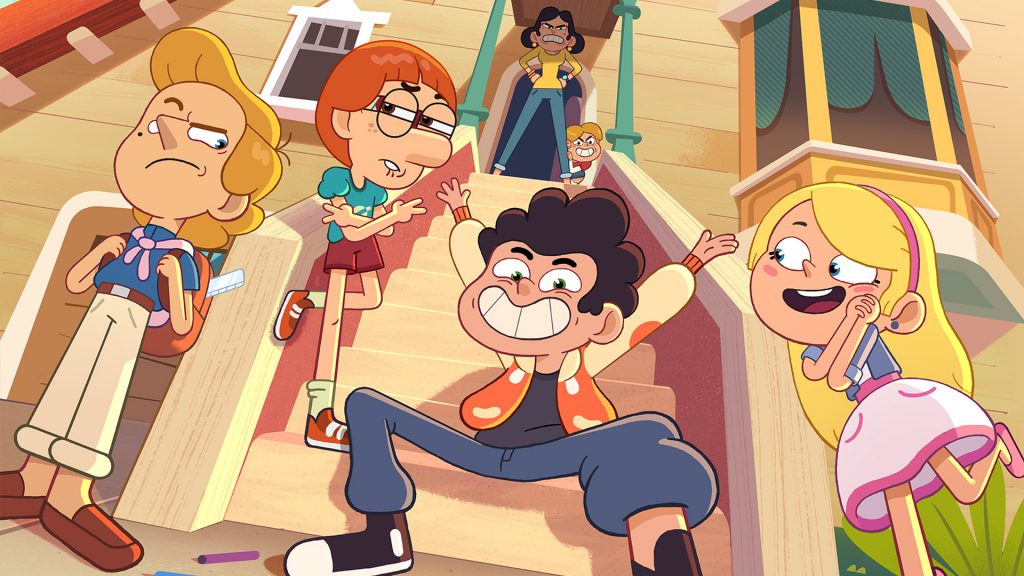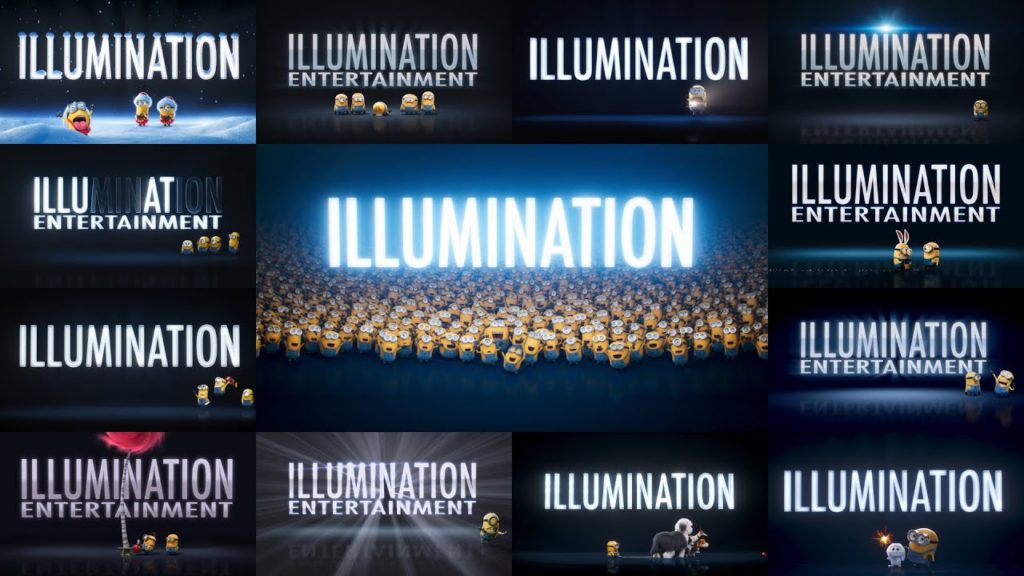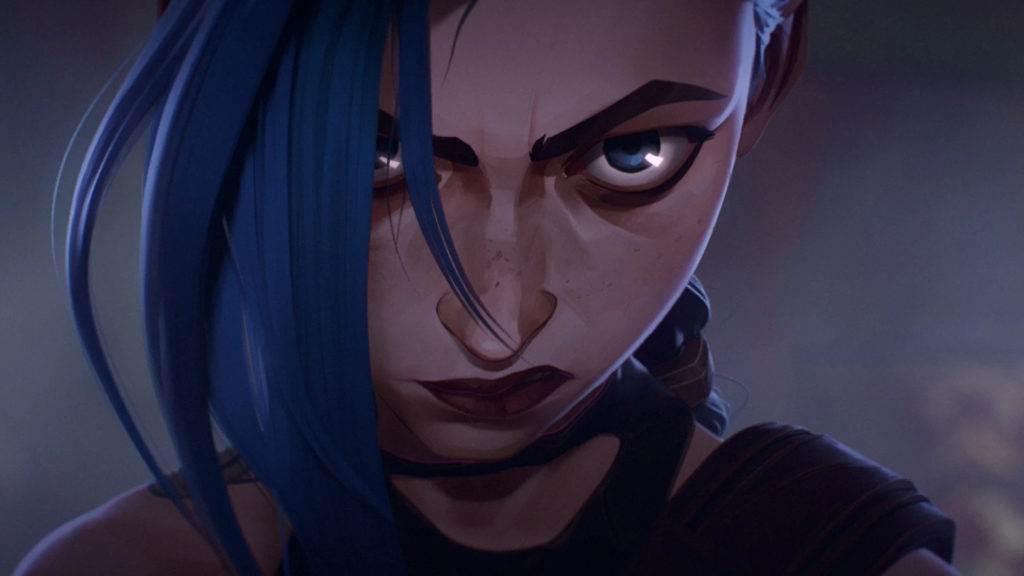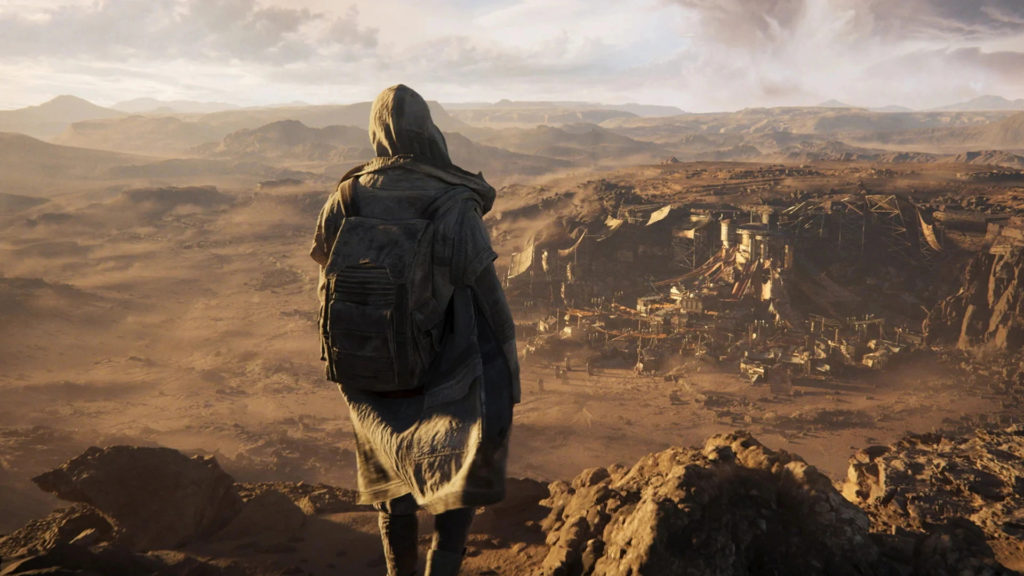MAKING OF LITTLE DOLL
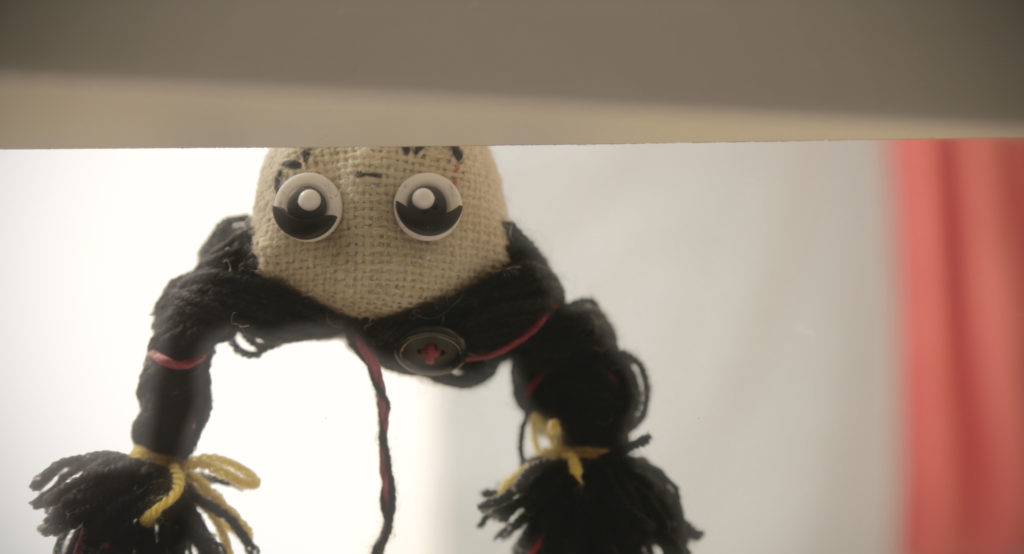
Welcome in this article about how I’ve made Little Doll, I hope you’ll enjoy it!
THE BEGINNING OF THE PROJECT
First, an idea: the wanted to create a short-film presenting my skills in the animation. As a person coming from a live-action school, with the desire to work in animation, it was vital for me to show what I was able to do in this domain. Second, different films I want to honor, that’ve inspired me during my childhood. And finally, imposed on me some technical ‘constraints’ I want to experiment with this film, test my limits.
That’s how Little Doll Story starts: a simple piece of paper, some drawings and words.
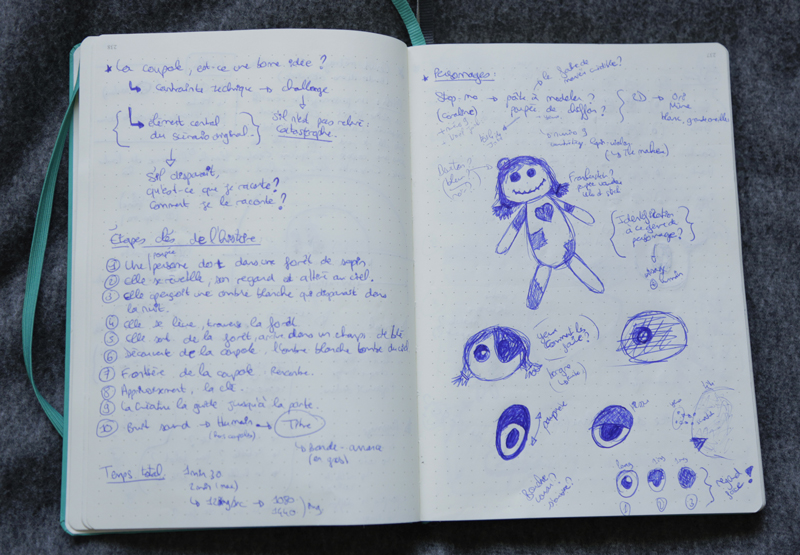
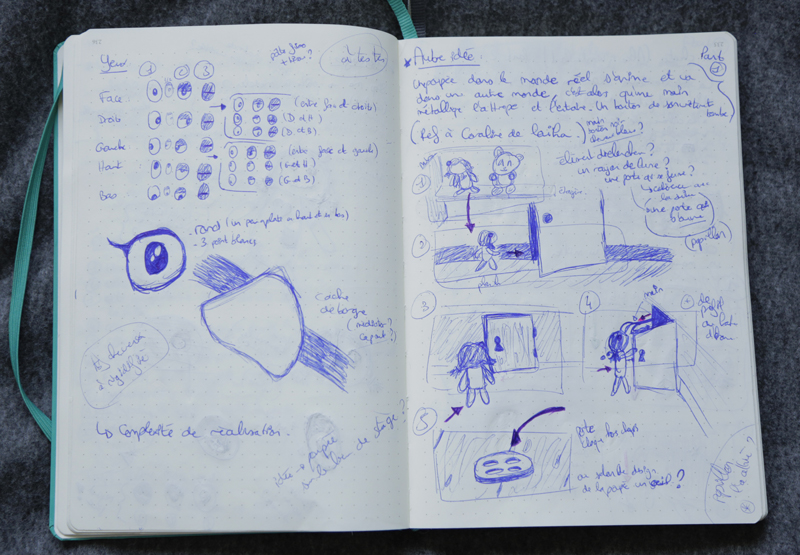
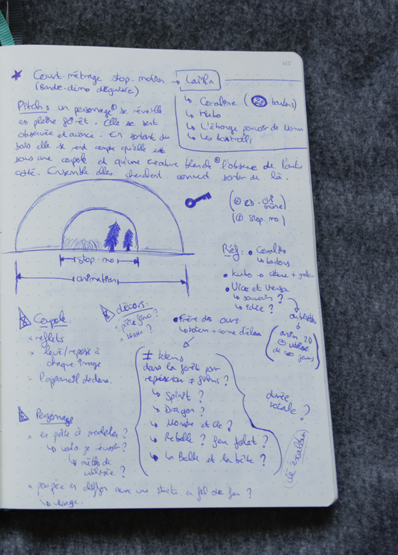
PREPRODUCTION : WRITING AND STORYBOARDING
The complete project took me around a year of time (not of work), it debuted in July 2017 and finished in May 2018. At first with the first completely unrealistic version of the story.
The point was, for me, to present the different techniques of animation I’d like to work with and in which I’ve got some skills at this moment: stop-motion, 2D animation, and a little bit of live-action.
In this perspective, I’ve begun to write a story about this doll waking up in a forest, she doesn’t have a clue where she is. And as she’s exploring the place she discovers that she is trapped under a bell of glass with a small door. During this time a white creature observes her from the outside, up to the moment they see each other. Then they exchange to find the key of the door. It’s waiting as the sword of Excalibur in a magnificent rock. Finally as they’re going to open the door, a huge human comes and touches the second glass bell where the white creature is locked, to tell them something, trying to help them out.
As you’ve understood it was a way to present the three techniques under each glass bell: the doll in stop-motion, the white creature in 2D animation and the live-action idea with the human.
But, of course, this was completely impossible with my resources and would bring more constraints (like the glass reflection, how to move everything around, etc.) than a real interest to present my skills, at this moment.
That’s why I’ve simplified the story with as principal reference Coraline, made by Laïka studios. In particular, the sequences where she follows the small mouse and discovers the passage to the other world.
This scene permitted me to honor this amazing film, and give me some reasonable constraints I could explore: movement of camera, animation with a 180° panoramic, animation of the hair falling down, etc.
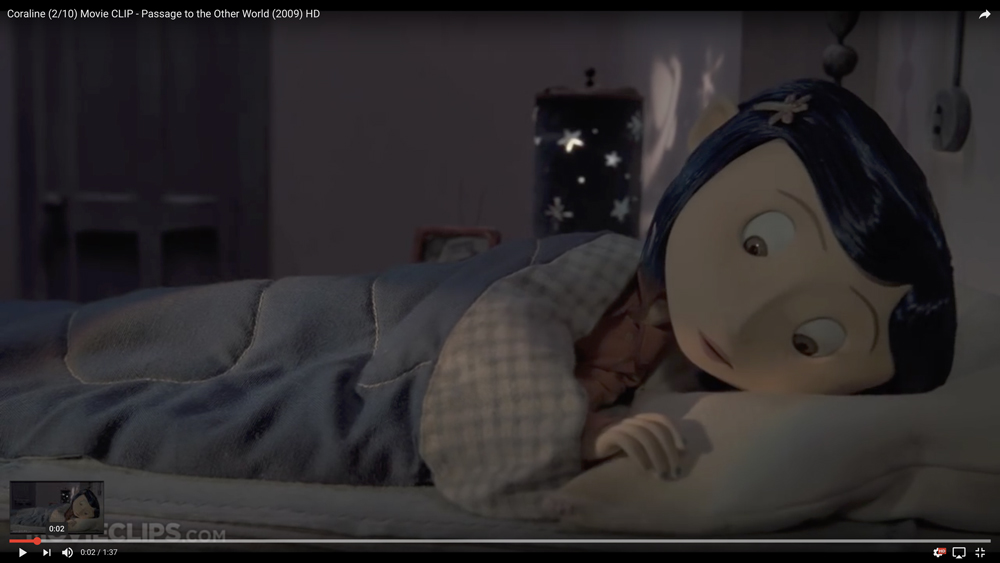
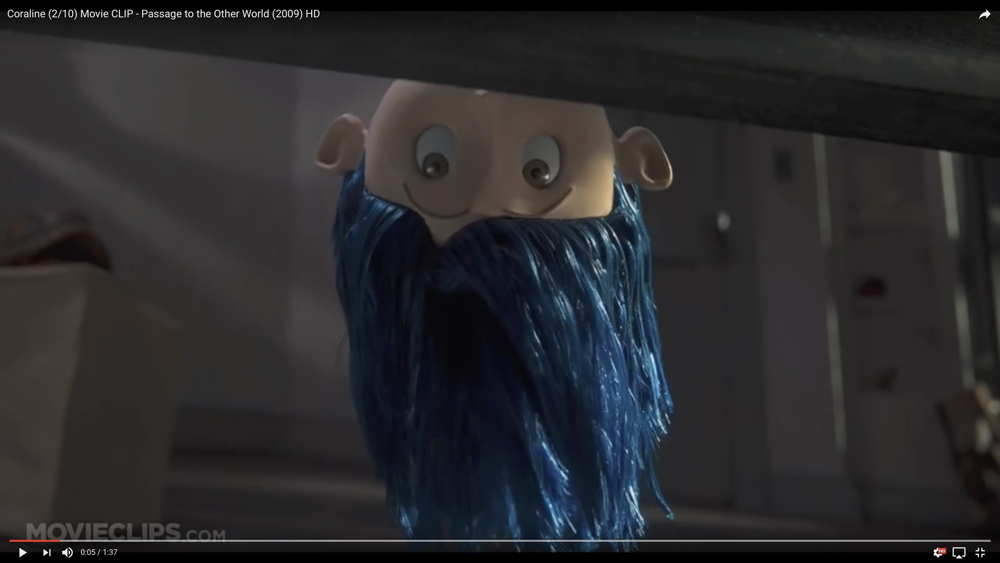
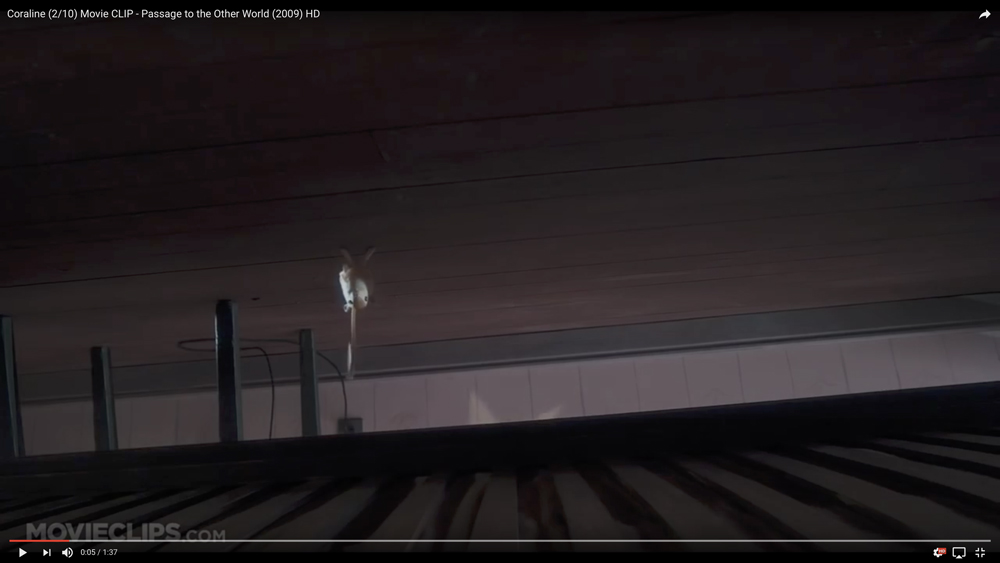
The first part of the short-film was born!
The second main reference that inspires Little Doll is Alice in Wonderland, made by Disney. Especially, the sequence of the fall, Alice is with all the objects out of time and gravity. This sequence permits me to honor this studio, and give me another constraint: animate a fall with a movement of camera, the animation of the hair and of other elements in suspension around.
It’s the idea of a hero’s journey: going to another world to learn something and grow, becoming an adult. This short-film is constructed with three parts that define the evolution of human being: from childhood to teenage years when you slowly gain in confidence to explore the world and then fall into adult age quite darker and scarier.
From my unrealistic idea of story, a synopsis came out:
“A doll is awakened by a paper butterfly that has come to her universe. She follows it up to a strange little door half-open. But when the doll comes closer a metal hand grabs her and takes her inside. She falls into a dark passage where some objects are floating without gravity, after a moment she finishes her fall and landed (crashed) in a forest of fir. After having recovered from her fall, the butterfly passes by and guides her eyes to a small creature. They are looking at each other when a thud sounds. The creature catches the doll by the hand and they flee. Suddenly a human appears and overlooks them with his mass.”
The main idea is still presents, but it hasn’t finished evolving: second writing the shooting and third the editing, but I’ll talk about it later.
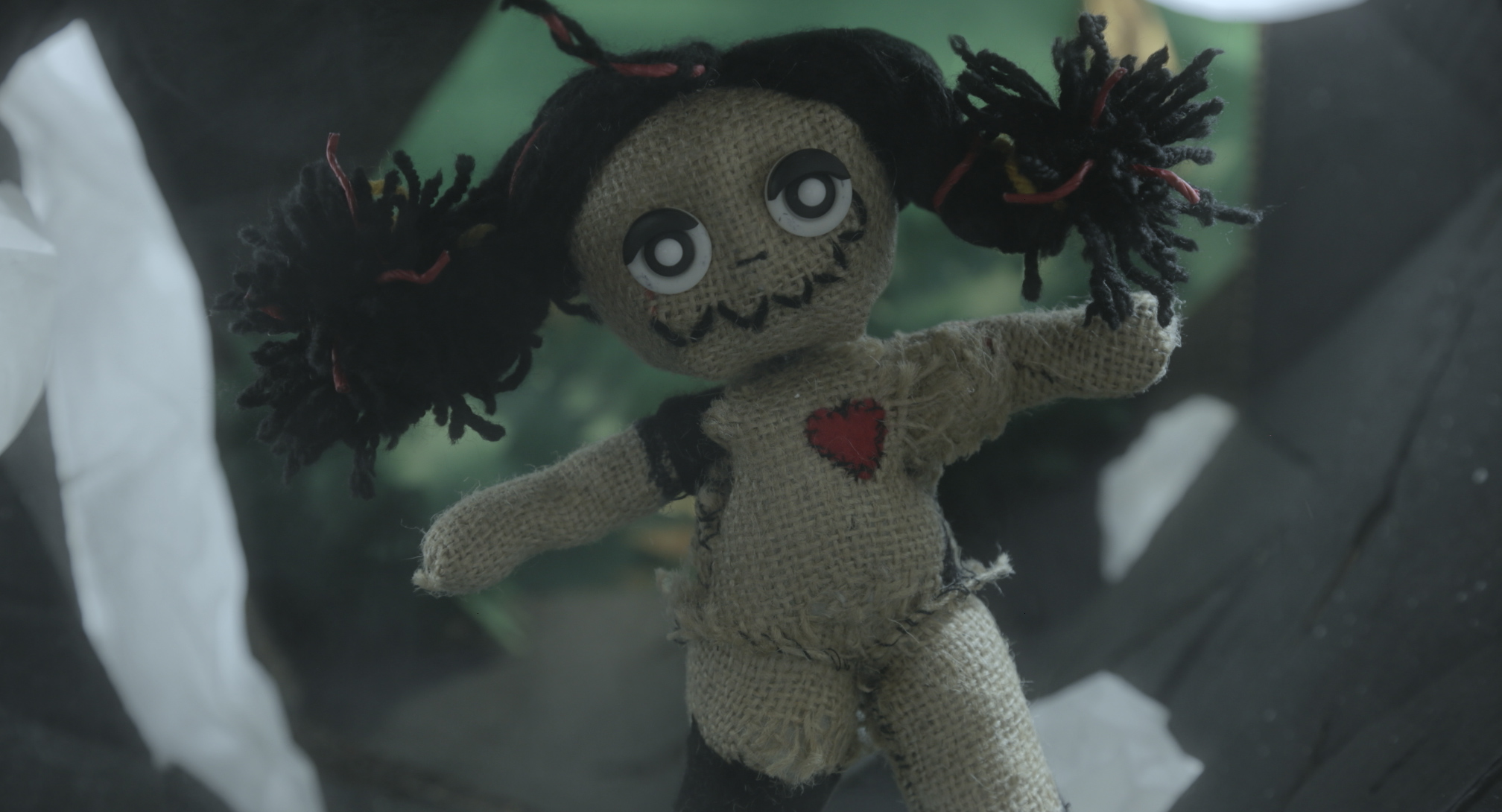
WORDS ARE GREAT, BUT IMAGES ARE BETTER : STORYBOARD TIME !
For each sentence I’ve got an image in mind, a way of telling my story with the angle of the shot, the composition, mostly visual elements because that’s what comes first in my mind.
This storyboard isn’t amazingly beautiful or aesthetic. It’s not the point, the goal was to understand what’s going on each shot, what’s happening, which movement of character and camera I’ll need to do, which sounds I’ll have to recreate after, will I need any additional information for post-production part, etc. to organize the shooting and make it as fluid as possible.
For example, putting together all the shots from the same side of the set, with the same need of installation, etc.
That’s all about what we want to do, how much time we have and how to make something as close as possible to the desired result with this small amount of time.
CREATION OF THE DOLL AND THE BACKGROUNDS
The creation of the puppet was my priority, it took me around one week. Thinking of the internal structure, making it as animable as possible, then the head of the doll, trying to be as close of my drawings as possible, and finally the body which needs to be strong enough to be animated during long hours and not break, but also manipulable and aesthetic.
It was easier for the background because it “only” needs to be pretty and stay in place. Still there were a lot of different places to create: the Child bedroom, the Little Door room, the Rabbit hole, and finally the Forest. It took me one more week too to create all the backgrounds. Then everything was ready for the shooting.
SHOOTING TIME
One week, that’s all the time I had to shoot everything. During these few days, I had to make choices, delete some shots, merge some others, to keep the meaning of the project but have all the material I would need for the post-production.
The studio where I was in internship at this moment: Jveb Studio let me use all their equipment: the set, LED lights, Dito Gear travelling and head, which permitted me to create a short film of quality.
I’ve shot in the chronological order of the story, places by places. The point was to see during the shooting:
1. If nothing was missing for each sequence, add or remove shots to gain in pertinence or time,
2. If each sequence were working one after another,
3. Add information on the storyboard about problems encountered during the shooting with first-in-mind solution…
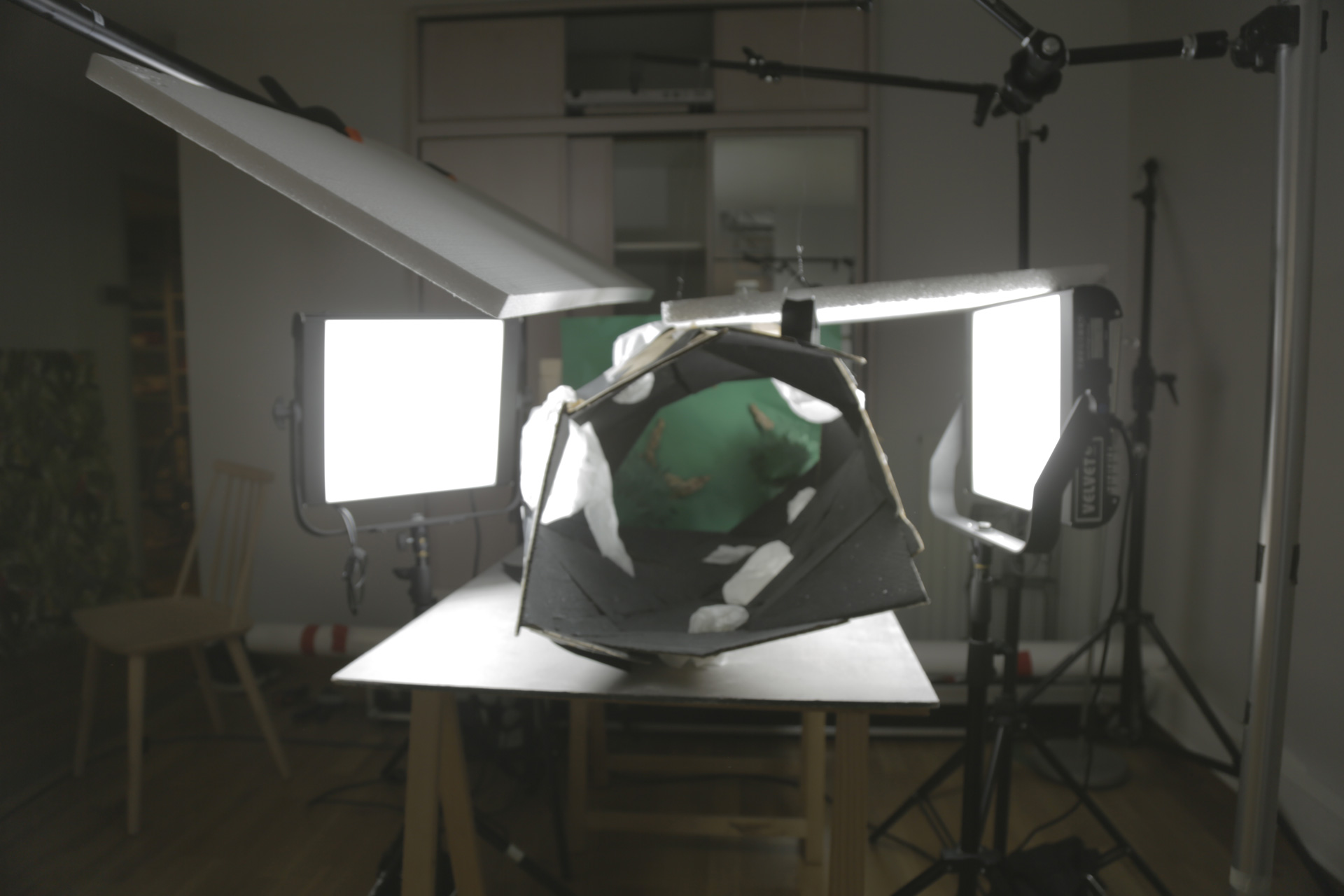
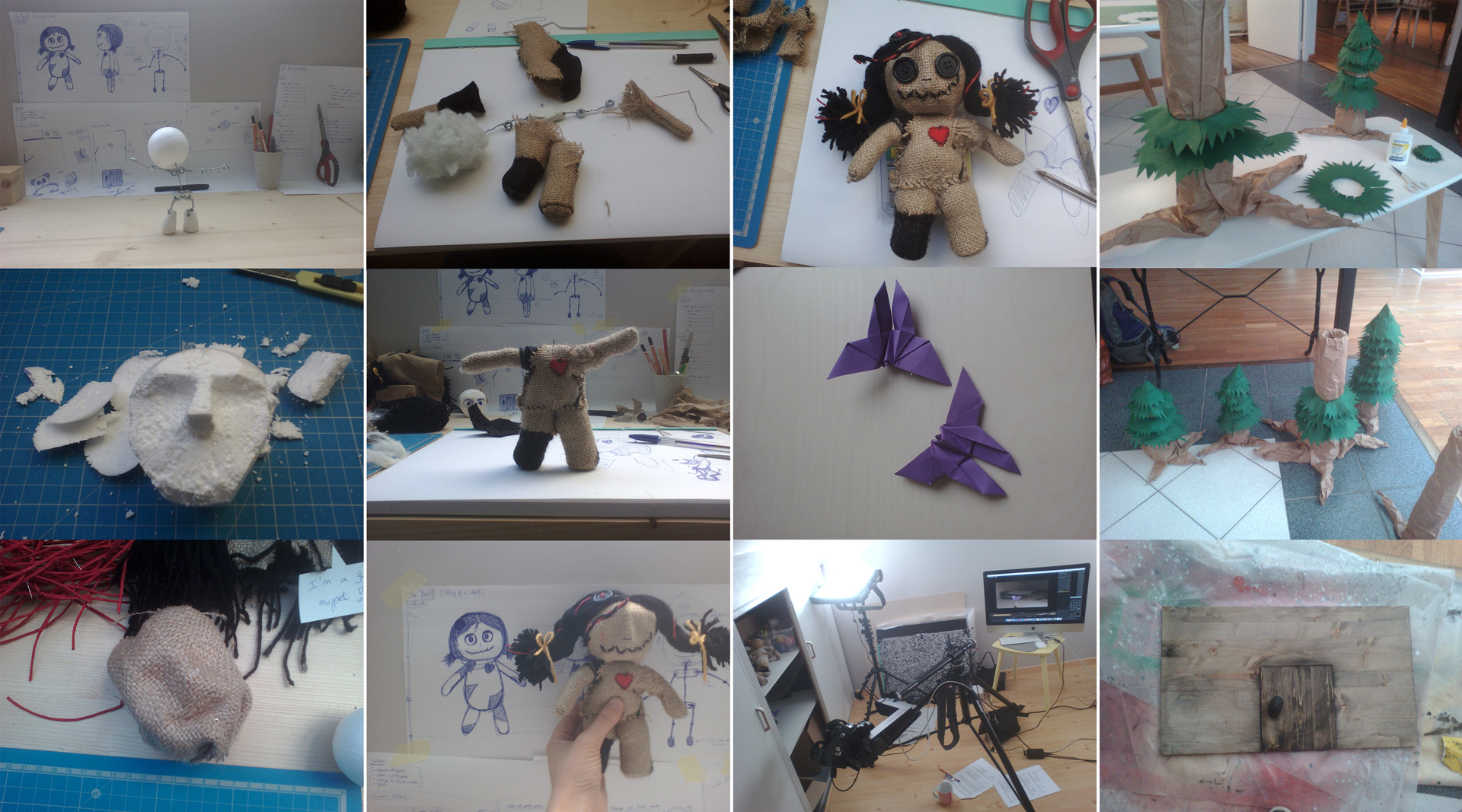
POST-PRODUCTION : EDITING, CLEANING, VFX, ETC.
September 2017 to May 2018, this is the period I’ve worked on the post-production during my free time. 8 months, for one minute.
How have I proceeded?
First: EDITING
The goal was to see if it was working properly, giving more rhythm and tension, and send it quickly to Killian, the music composer, to give him enough time to create.
In parallel of Killian’s work, a lot of work on the visual aspect of the film was waiting. In each shot I’ve used some armatures, great to keep every object in place and gain in precision, these elements weren’t supposed to be seen by the audience.
So: CLEANING TIME
To be efficient I’ve created a simple document, which shows clearly:
• A visual of the shot,
• Its reference/name with the timecode used,
• What needed to be done: erase the armature, something moving during the shoot and needed to be freezed, etc.,
• The priority of it: essential or less vital to the understanding of the story,
• Other informations about it,
• Is it done? Yes / No.
This document helped me to keep track of what I was doing, what needed to be done, how much work was already done, and go on quickly to the next shot.
I’ve made a few mistakes during the shooting, like letting the armatures’ feet in the shadow of the doll on a few shots which forced me to recreate properly the shadows. That’s a lesson I’ve learned and will be really careful about for my next stop-motion short film.
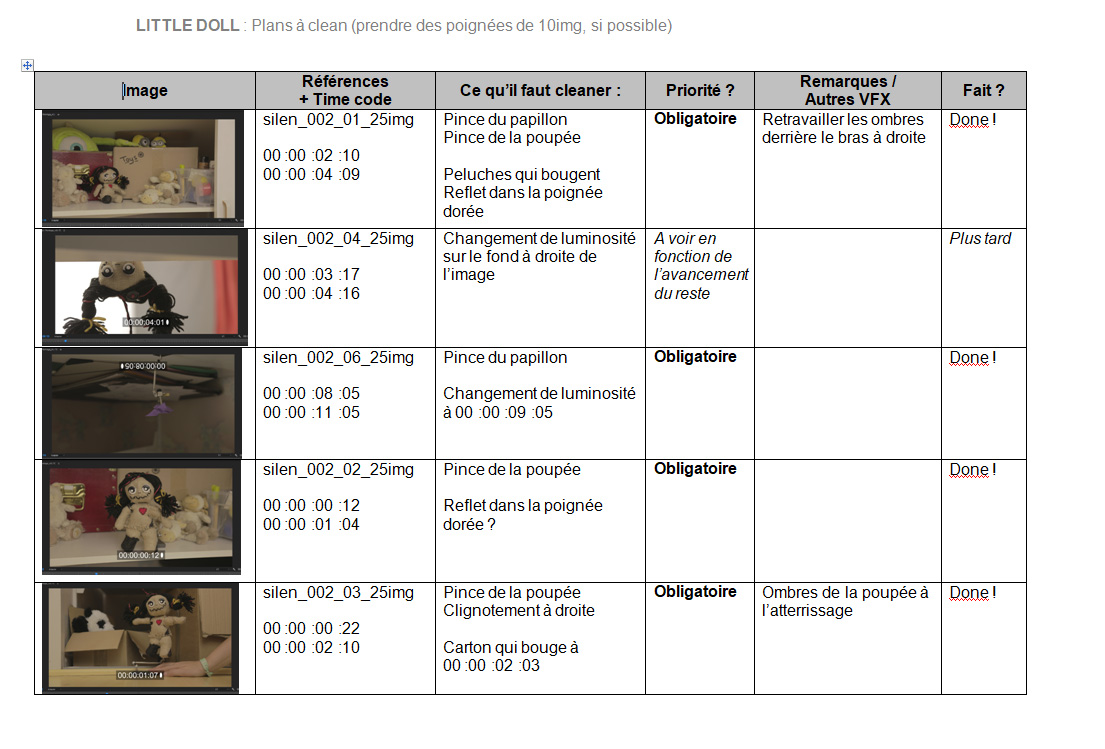
Next: VFX IT’S YOUR TURN
On this project the vfx were quite discreet, my goal was to underline some elements and make the visual aspect as clean as possible. Most of the vfx were more discreet, adding some particles to give a living aspect to the images, some fog to make the forest more mysterious.
Then some effects more visible, like the lines around the teddy bear, button and purple hand, why this effect? With the whish to show my desire to work in every kind of animation film, this line represented the traditional 2D animation.
The Doll represented the stop-motion, the creature at the end, the 2D cut-out, and the Human hand at the really end the live-action part that still interest me.
The 2D creature was animated with DUIK on After Effects and integrated as much as possible to make it believable in the universe but I wanted to keep the numeric texture of it to clearly show its 2D aspect.
Nearly finish: COLOR GRADING
Last step: TITLE AND END CREDITS
The title and end credits were done at the end of the process. With a small animation of the important text by re-drawing the name of the persons a few times to make them alive.
THANKS AND CONCLUSION
To finish, I want to thank all the persons who participated to create it.
Cédric Bra and Hana Aouak, my internship masters and first managers from Jveb Studio, for teaching me the art of stop-motion, for letting me try, fail, retry, succeed in the process, for believing in me, for giving me the possibility to create such a quality short-film with their equipment, for all of that and so much more: thank you!
Joelle Kristy, for the hours you spent watching the short film again and again to give me your best editing advices to help me make it so close to perfection, for your support: thank you!
Sharon Smith Holley, Nick Willard, Matt Michael, Emma DuPell Pradhan, Nathalie Karouni, Joshua Kirchmer, Meaghan Wilbur and Kate Ferry, for your precious advices. And a special thanks to Frédéric Michaud for your advices and help to create the DCP.
Finally, a big thank you to the people who helped me with their talents: Kekenko creating the fimo objects with such precision and Killian Gravil for the composition of this awesome music and supporting me during the post-production: THANK YOU ALL!
This project really permitted me to confront myself to the problematics of this kind of production, find solutions to make everything as clean as possible and gain in confidence in my skills to create a short film from the beginning to the end with this quality at this moment.
I hope you’ve enjoyed reading this and watching the film!
If you want to rewatch it just follow this link.
FESTIVAL SELECTION
Animation Nights New York (New York),
Los Angeles Cine Fest (online fest),
Anilogue International Animation Festival (Budapest),
Queen City Film Festival (Maryland)
MAKING OF LITTLE DOLL

Welcome in this article about how I’ve made Little Doll, I hope you’ll enjoy it!
THE BEGINNING OF THE PROJECT
First, an idea: the wanted to create a short-film presenting my skills in the animation. As a person coming from a live-action school, with the desire to work in animation, it was vital for me to show what I was able to do in this domain. Second, different films I want to honor, that’ve inspired me during my childhood. And finally, imposed on me some technical ‘constraints’ I want to experiment with this film, test my limits.
That’s how Little Doll Story starts: a simple piece of paper, some drawings and words.



PREPRODUCTION : WRITING AND STORYBOARDING
The complete project took me around a year of time (not of work), it debuted in July 2017 and finished in May 2018. At first with the first completely unrealistic version of the story.
The point was, for me, to present the different techniques of animation I’d like to work with and in which I’ve got some skills at this moment: stop-motion, 2D animation, and a little bit of live-action.
In this perspective, I’ve begun to write a story about this doll waking up in a forest, she doesn’t have a clue where she is. And as she’s exploring the place she discovers that she is trapped under a bell of glass with a small door. During this time a white creature observes her from the outside, up to the moment they see each other. Then they exchange to find the key of the door. It’s waiting as the sword of Excalibur in a magnificent rock. Finally as they’re going to open the door, a huge human comes and touches the second glass bell where the white creature is locked, to tell them something, trying to help them out.
As you’ve understood it was a way to present the three techniques under each glass bell: the doll in stop-motion, the white creature in 2D animation and the live-action idea with the human.
But, of course, this was completely impossible with my resources and would bring more constraints (like the glass reflection, how to move everything around, etc.) than a real interest to present my skills, at this moment.
That’s why I’ve simplified the story with as principal reference Coraline, made by Laïka studios. In particular, the sequences where she follows the small mouse and discovers the passage to the other world.
This scene permitted me to honor this amazing film, and give me some reasonable constraints I could explore: movement of camera, animation with a 180° panoramic, animation of the hair falling down, etc.



The first part of the short-film was born!
The second main reference that inspires Little Doll is Alice in Wonderland, made by Disney. Especially, the sequence of the fall, Alice is with all the objects out of time and gravity. This sequence permits me to honor this studio, and give me another constraint: animate a fall with a movement of camera, the animation of the hair and of other elements in suspension around.
It’s the idea of a hero’s journey: going to another world to learn something and grow, becoming an adult. This short-film is constructed with three parts that define the evolution of human being: from childhood to teenage years when you slowly gain in confidence to explore the world and then fall into adult age quite darker and scarier.
From my unrealistic idea of story, a synopsis came out:
“A doll is awakened by a paper butterfly that has come to her universe. She follows it up to a strange little door half-open. But when the doll comes closer a metal hand grabs her and takes her inside. She falls into a dark passage where some objects are floating without gravity, after a moment she finishes her fall and landed (crashed) in a forest of fir. After having recovered from her fall, the butterfly passes by and guides her eyes to a small creature. They are looking at each other when a thud sounds. The creature catches the doll by the hand and they flee. Suddenly a human appears and overlooks them with his mass.”
The main idea is still presents, but it hasn’t finished evolving: second writing the shooting and third the editing, but I’ll talk about it later.
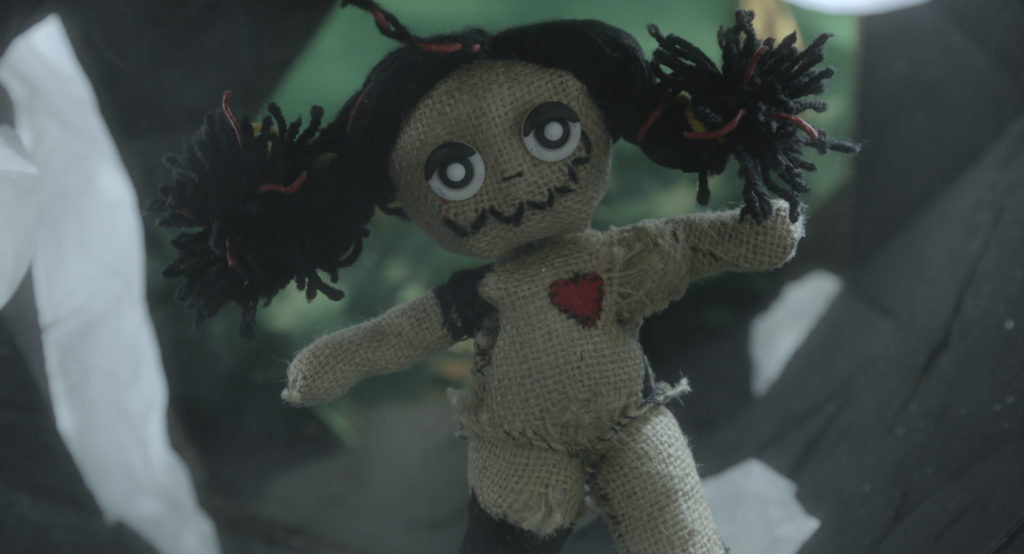
WORDS ARE GREAT, BUT IMAGES ARE BETTER : STORYBOARD TIME !
For each sentence I’ve got an image in mind, a way of telling my story with the angle of the shot, the composition, mostly visual elements because that’s what comes first in my mind.
This storyboard isn’t amazingly beautiful or aesthetic. It’s not the point, the goal was to understand what’s going on each shot, what’s happening, which movement of character and camera I’ll need to do, which sounds I’ll have to recreate after, will I need any additional information for post-production part, etc. to organize the shooting and make it as fluid as possible.
For example, putting together all the shots from the same side of the set, with the same need of installation, etc.
That’s all about what we want to do, how much time we have and how to make something as close as possible to the desired result with this small amount of time.
CREATION OF THE DOLL AND THE BACKGROUNDS
The creation of the puppet was my priority, it took me around one week. Thinking of the internal structure, making it as animable as possible, then the head of the doll, trying to be as close of my drawings as possible, and finally the body which needs to be strong enough to be animated during long hours and not break, but also manipulable and aesthetic.
It was easier for the background because it “only” needs to be pretty and stay in place. Still there were a lot of different places to create: the Child bedroom, the Little Door room, the Rabbit hole, and finally the Forest. It took me one more week too to create all the backgrounds. Then everything was ready for the shooting.
SHOOTING TIME
One week, that’s all the time I had to shoot everything. During these few days, I had to make choices, delete some shots, merge some others, to keep the meaning of the project but have all the material I would need for the post-production.
The studio where I was in internship at this moment: Jveb Studio let me use all their equipment: the set, LED lights, Dito Gear travelling and head, which permitted me to create a short film of quality.
I’ve shot in the chronological order of the story, places by places. The point was to see during the shooting:
1. If nothing was missing for each sequence, add or remove shots to gain in pertinence or time,
2. If each sequence were working one after another,
3. Add information on the storyboard about problems encountered during the shooting with first-in-mind solution…
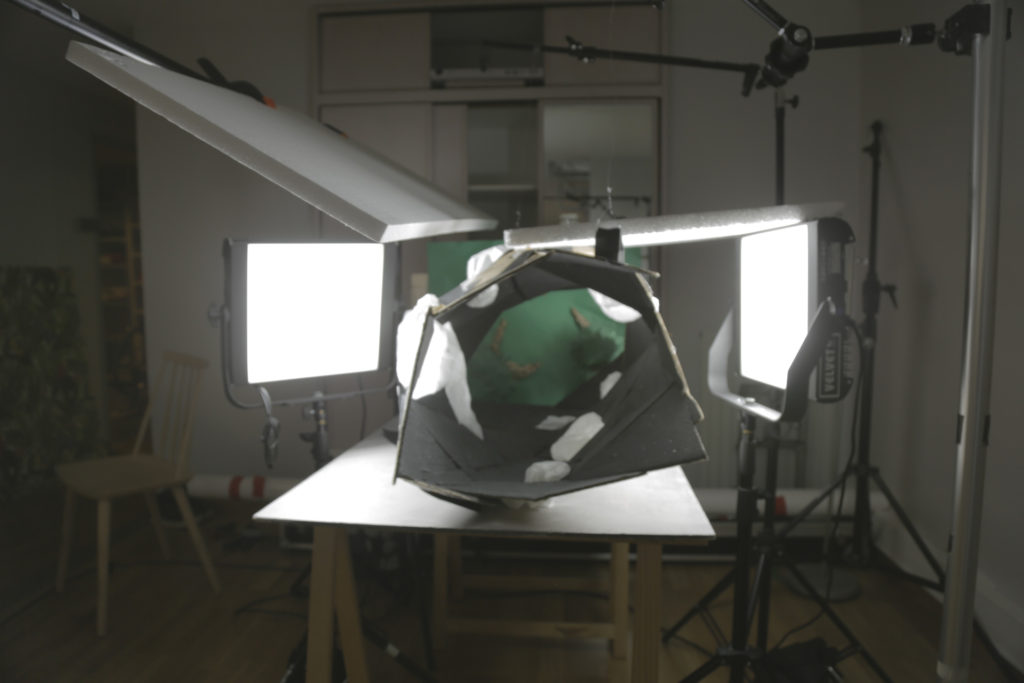
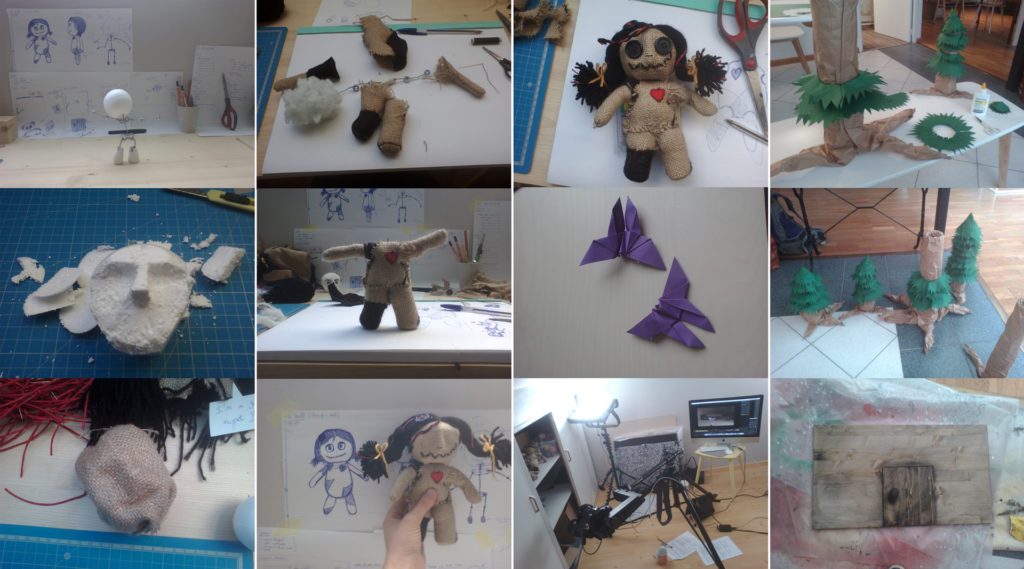
POST-PRODUCTION : EDITING, CLEANING, VFX, ETC.
September 2017 to May 2018, this is the period I’ve worked on the post-production during my free time. 8 months, for one minute.
How have I proceeded?
First: EDITING
The goal was to see if it was working properly, giving more rhythm and tension, and send it quickly to Killian, the music composer, to give him enough time to create.
In parallel of Killian’s work, a lot of work on the visual aspect of the film was waiting. In each shot I’ve used some armatures, great to keep every object in place and gain in precision, these elements weren’t supposed to be seen by the audience.
So: CLEANING TIME
To be efficient I’ve created a simple document, which shows clearly:
• A visual of the shot,
• Its reference/name with the timecode used,
• What needed to be done: erase the armature, something moving during the shoot and needed to be freezed, etc.,
• The priority of it: essential or less vital to the understanding of the story,
• Other informations about it,
• Is it done? Yes / No.
This document helped me to keep track of what I was doing, what needed to be done, how much work was already done, and go on quickly to the next shot.
I’ve made a few mistakes during the shooting, like letting the armatures’ feet in the shadow of the doll on a few shots which forced me to recreate properly the shadows. That’s a lesson I’ve learned and will be really careful about for my next stop-motion short film.
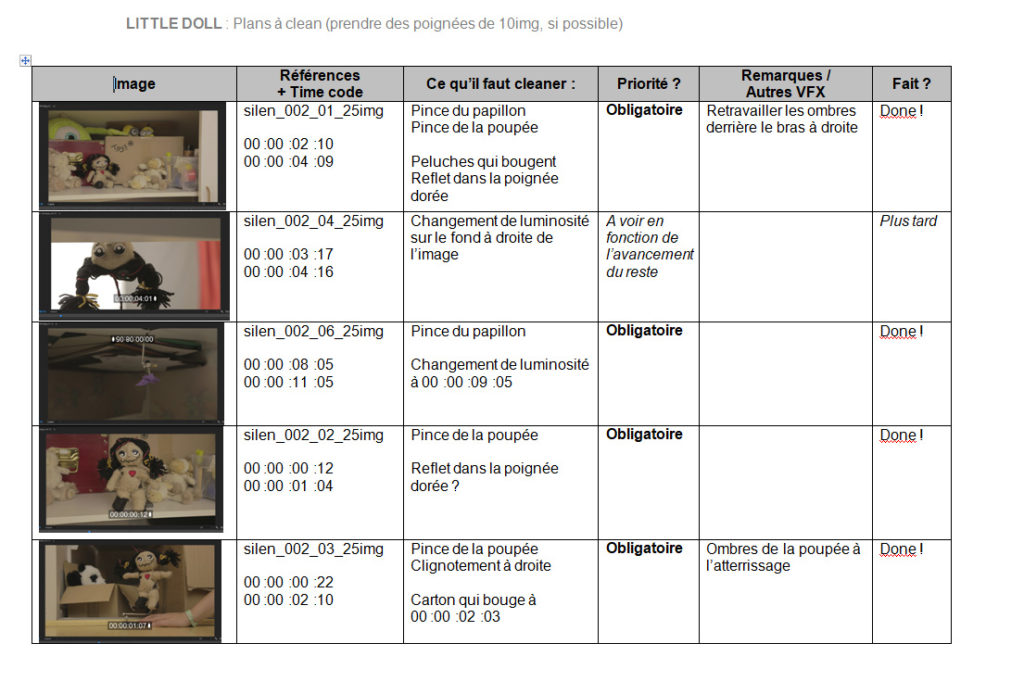
Next: VFX IT’S YOUR TURN
On this project the vfx were quite discreet, my goal was to underline some elements and make the visual aspect as clean as possible. Most of the vfx were more discreet, adding some particles to give a living aspect to the images, some fog to make the forest more mysterious.
Then some effects more visible, like the lines around the teddy bear, button and purple hand, why this effect? With the whish to show my desire to work in every kind of animation film, this line represented the traditional 2D animation.
The Doll represented the stop-motion, the creature at the end, the 2D cut-out, and the Human hand at the really end the live-action part that still interest me.
The 2D creature was animated with DUIK on After Effects and integrated as much as possible to make it believable in the universe but I wanted to keep the numeric texture of it to clearly show its 2D aspect.
Nearly finish: COLOR GRADING
Last step: TITLE AND END CREDITS
The title and end credits were done at the end of the process. With a small animation of the important text by re-drawing the name of the persons a few times to make them alive.
THANKS AND CONCLUSION
To finish, I want to thank all the persons who participated to create it.
Cédric Bra and Hana Aouak, my internship masters and first managers from Jveb Studio, for teaching me the art of stop-motion, for letting me try, fail, retry, succeed in the process, for believing in me, for giving me the possibility to create such a quality short-film with their equipment, for all of that and so much more: thank you!
Joelle Kristy, for the hours you spent watching the short film again and again to give me your best editing advices to help me make it so close to perfection, for your support: thank you!
Sharon Smith Holley, Nick Willard, Matt Michael, Emma DuPell Pradhan, Nathalie Karouni, Joshua Kirchmer, Meaghan Wilbur and Kate Ferry, for your precious advices. And a special thanks to Frédéric Michaud for your advices and help to create the DCP.
Finally, a big thank you to the people who helped me with their talents: Kekenko creating the fimo objects with such precision and Killian Gravil for the composition of this awesome music and supporting me during the post-production: THANK YOU ALL!
This project really permitted me to confront myself to the problematics of this kind of production, find solutions to make everything as clean as possible and gain in confidence in my skills to create a short film from the beginning to the end with this quality at this moment.
I hope you’ve enjoyed reading this and watching the film!
If you want to rewatch it just follow this link.
FESTIVAL SELECTION
Animation Nights New York (New York),
Los Angeles Cine Fest (online fest),
Anilogue International Animation Festival
(Budapest),
Queen City Film Festival (Maryland)








